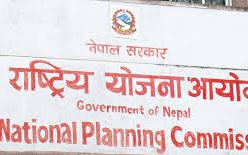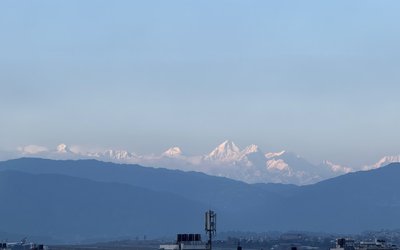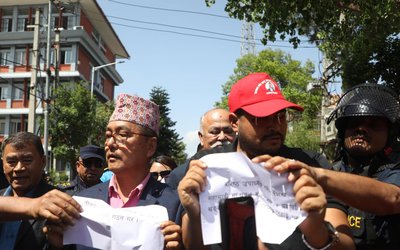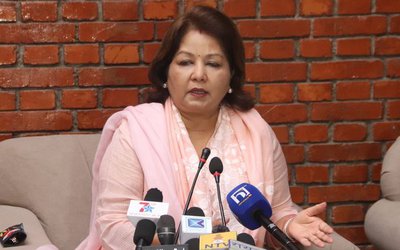
Naina Nepal, 30, who has been living in self-isolation, suddenly felt the lowering of the oxygen level. In a rush, her husband, who himself was infected with COVID-19, knocked on the doors of several hospitals for four hours. His efforts went in vain. Finally, she was admitted to Kantipur Dental Hospital.
The supply of oxygen stabilized her situation. However, the isolation ward run by the hospital was without medical staff, nurses and doctors. With the spike of COVID-19, Nepal’s health system has suddenly faced a great strain. The Ministry of Health, which is unable to bring vaccines and add hospital beds, has issued a statement saying that the healthcare system had been overwhelmed.
“Telephone is ringing. Covid cases are skyrocketing. Hospitals seem overwhelmed. Time to lock down to give a breathing chance to the medical world. My prayers to our colleagues who are working day and night in India helping Covid cases. A similar situation is coming to Nepal too. Now, alarming! Patients are calling for help. ICU beds! Cannot breathe! Requesting for beds! I am calling hospitals including ours. Requesting my friends for help. They look desperate and asking me what will happen if staffs get sick? Sir, you take care as no beds are available!,” tweets Dr. Chakra Raj Pandey, Consultant Orthopedic Surgeon, Medical Director at Grande International Hospital and Director of Sports Medicine, Arthroscopy, and Joint Replacement.
With all these in the background, the Ministry of Health and Population (MoPH) has said that the nation’s healthcare system had been overwhelmed with the spike in infections and appealed for everyone to remain careful.
The Health Ministry in a press statement said the COVID-19 cases in Nepal have been mounting in an alarming manner in recent times.
According to the Ministry, the infection rate in 22 districts has been increasing at a higher rate. Those 22 districts include Morang, Sunsari, Jhapa, Parsa, Bara, Dhanusa, Kathmandu, Bhaktapur, Lalitpur, Chitwan, Makwanpur, Kavrepalanchowk, Kaski, Dang, Banke, Rupandehi, Palpa, Bardiya, Kapilvastu, Surkhet, Kailali and Kanchanpur.
“A grave situation has already arrived as the health system is not being able to provide beds for the treatment of infected patients,” said the ministry, appealing to everyone to stay alert and duly follow all the health safety standards.
“Wearing masks, maintaining physical distance and frequently washing hands are the best way to prevent the infection,” added the ministry. MoHP said that it was vital to immediately halt crowding in public places and prevent mobility in and outside the nation.
With the case spike, major government hospitals in Kathmandu Valley have run out of bed for the treatment of the infected persons.
According to the Health Emergency Operation Center (HEOC), Teaching Hospital, Armed Police Force Hospital, Patan Hospital, Civil Service Hospital, Bhaktapur Hospital, Bir Hospital as well as Dhulikhel Hospital are in shortage of beds for COVID-19 patients.
Dr Achyut Karki, the spokesperson of the Bir Hospital, said that the 100-120 oxygen beds of Bir Hospital have already been occupied with the COVID-19 patients.
We are planning to add more beds but with these surging cases, the system will face a severe crisis. If this continues, then we will be helpless, said Dr. Karki.
Dr. Sumitra Gautam, a spokesperson of the Bhaktapur Hospital, said that all of the 68 general beds are full. Six ICU beds are also packed. There are some beds left in the High Care Unit (HCI), but more than 10-12 patients are waiting for the beds.
We now fear oxygen shortage. We were somehow managing the oxygen up to now. But, within a few days, we will run out of oxygen too. The oxygen plant of Bhaktapur is not in good condition, said Dr. Gautam.
Dr. Prabin Nepal, Superintendent of Police (SP) of the Armed Police Force Hospital, Balambhu, said that all the beds and ventilators of the hospital are full.
There are 140 beds in the COVID-19 ward, of them, 136 are full. All the eight ventilators are occupied by the COVID-19 patients, added Dr. Nepal.
Dr. Samir Kumar Adhikari, Chief of National Health Emergency Operation Center (HEOC), said that Nepal can have a shortage of oxygen cylinders. The beds of COVID-19 patients are being added but the cases seem to rise exponentially as well.
Dr. Adhikari urged the denizens to help break the chain of the virus by being alert and following the health safety protocols and acting sensibly during prohibitory orders.
Meanwhile, the Ministry of Health and Population (MoHP) has issued a notice appealing for denizens to adhere to health safety protocols as well as to strictly follow the prohibitory order citing the exponential rise of COVID-19 cases.
The public notice acknowledges that the health system is facing a severe crisis and that it is facing strain in providing treatment and beds to surging COVID-19 cases.
Prohibitory Order
Along with Kathmandu Valley, several other districts have announced prohibitory orders and other such measures. The District Administration Offices of Kathmandu, Bhaktapur and Lalitpur have issued prohibitory orders for the valley effective from April 29.
“Lockdown is essential at this stage to minimize uncontrolled proliferation/mass transmission of virus! It is the extreme measure of physical distancing:#StayHomeStaySafe! During this Gov must enhance hospital preparedness for testing tracing,care&cure! Not done? No improvement why?” Prof.Dwij Raj Bhatta, professor of Microbiology wrote in his tweet. “Hospitals are overburdened with severe COVIDcases!4800+ve&35 fatalities reported today, mostly in Kathmandu! Many will require hospitalization if severe symptoms develop! But where to go? Hope Lockdown imposed in Kathmandu from today will break the transmission chain! #StayHomeStaySafeFolded hands.”
A meeting of chiefs of the three districts, that had lasted for hours, decided to enforce prohibitory orders keeping in mind the sharp spike in daily reported cases of Covid-19 in all the three districts of the valley.
“Government of Nepal's decision on lockdown is the most important and welcome step as a breather. Now, hospitals have to focus on emergency care only. Every resource has to be directed to covid care. GON has to utilize all hospital beds, private and public, in the most subsidized rate,” tweets Dr. Pandey.
As per the CDOs' decision, vehicles other than emergency service vehicles, will not be allowed to ply the roads while essential supply stores will have a set window of time for operation, according to a DAO source.
Kathmandu valley, on that day, had reported close to 1,500 infections, almost half of the total number of daily cases logged throughout the country.
Dr. Luna Bhatta Sharma, Ph.D. Medical Science (Virology), Osaka City University Medical School, Japan, tweets the government finally said "we quit." Or we can't do, it is beyond our capacity? “What about the irresponsible statements given by our pm on covid,15 days ago! Gargling, guava leaves. thori ram yatra was more important to him. Better, they leave, let others do it !”
How Nepal's Second Covid wave started, what went wrong
Since April, Nepal has been witnessing a surge in Covid-19 infections with the country seeing over 6000 fresh cases of Covid-19 daily. This massive surge has caused a visible strain on the healthcare system.
Amid the second wave of Covid-19, healthcare personnel in Nepal have been trying to do their best under trying circumstances. Stretched to the breaking point, the pressure of work and shortage of material during the second wave may cause deaths that could have been avoidable.
“The so-called UK variant was detected in September 2020. That was an alert for Nepal to be on guard and look systematically for variants of concern. In December, the lab consortium was networked but the goal of gene sequencing in 5 percent of all cases was not taken seriously,” said experts.
Like in earlier pandemics of influenza and like in other countries, the second wave of Covid-19 has happened in Nepal. The second wave is different and more worrying than the first.

Deaths are proportionate to infections and that proportion may not necessarily be any different than the first wave. But we will have to wait and see. As of now, the infection-fatality or case-fatality seems to be unchanged. Infection-fatality and case-fatality are not easily dissected in India because of the way numbers are reported. But consistently it has remained below two. More infections will cause more deaths. While healthcare staff is better informed, the sheer pressure of work and shortage of resources may cause more deaths.
Bishal Bhandari, MD MBA, tweets, “We are seeing many Projections, many talks about IHME's number, I have referenced more than 20 of them and my personal favorite is this model, which shows by May end the current total of 323187 would easily be doubled. We are hitting the high projection range, this is worrisome (3)
The system was slow to look for and detect mutant variants of concern. Reports in the media indicate that younger age groups, largely unaffected in the first wave, are now getting infected. Whether this is indicative of higher infectiousness will be known as studies are reported. Probably the higher infectiousness alone may explain this change.
“COVID-19 Nepal. Look how fast the infection is spreading. (Based on new cases in last 14 days adjusted to population, Apr 15 and Apr 29). 57 districts are between Moderate to Highest Risk (74%). This is bad, very bad,” tweets Bhandari.
Vaccination is a very important intervention. But an impact on epidemiology can be had only after two doses and a sizeable proportion are vaccinated to give a guess, at least 25-30 percent. As of now, around 2 percent has been given two doses. Stepping up vaccinations will not affect the rise of second-wave, but it will definitely save many lives. I do not think India can conduct mass vaccinations in order to make an impact on epidemiology now, as vaccine supplies will not meet this demand.
The government and scientific community did not expect a second wave, or a wave of this magnitude, as the first wave was a one-year affair. It took six months to reach the peak and six months to decline to steady and low numbers. From December 27 till March 11, the daily numbers were around 20,000 and that pattern was assumed to continue. However, that is no excuse for not being ready for an increase until at least 30% of the population was vaccinated.
Mutant variants are a function of the magnitude of infection: a greater number of people infected means more chances of variants of concern. So, more mutants were predictable, but would the mutants be of concern or not have to be specifically investigated?

The double mutant was a variant detected late last year, but its impact was not investigated until the second wave threw up questions. The classification of the double mutant is B.1.617 and it seems to be the dominant virus in Maharashtra. Not sure where else it has been detected.
UK variant B.1.1.7 was detected in September 2020, only because of routine genome sequencing. Similarly, South African variant B.1.351 was found in October 2020.
Satish Pandey tweets, “No change in symptoms and infections for B117. compared to a pre-existing virus. R1 increased to 1.35 for B117 but the lockdown was useful to bring R1 down below 1 even in areas with a high proportion of infections with the variant.”
The Brazil variant P.1 was detected since Japan was doing routine gene sequencing; in Dec 2020, Japan picked up a variant in four persons. All had traveled from Brazil then Brazilian viruses were analyzed and P.1 was dominant there. Genome studies are very important for the management of the epidemic.
Festivals, marriage ceremonies, if conducted with all due precautions, are not likely to trigger a surge in cases. But the processions and massive meetings, definitely put a huge number of people at risk of getting infected and worse, spreading it. Everyone knew that it was like a smoldering fire, which would flare-up.
Covid is now in pandemic form -- all countries having epidemics. The epidemic phase will be gotten over with and all countries will continue to have "endemic" (low and stable) presence of the disease and its infection. “With the majority getting infected, and vaccines getting rolled out, I hope that we will be reaching endemic phase (staggered country-by county), sometime in last quarter 0f 2021 or early 2022.”
Nepal Closes Border
Nepal announced the suspension of visas upon arrival for nationals from any country. Those travelers already possessing a prior valid Nepali visa will be required to submit a swab test PCR health certificate issued a maximum of 72 hours before arrival to Nepal to the immigration office at Tribhuvan International Airport. Similarly, Nepal closed all border points with India till further notice.

Those Nepalis who want to enter home, have to present PCR Negative test before entering Nepal and have to go mandatory 10 days quarantine in the home under the supervision of local bodies.
- NEPAL-THAILAND: Joint Business Council
- Apr 13, 2025
- BIMSTEC SUMMIT: Nepal’s Stand
- Apr 11, 2025
- IME GROUP: Expands Into Paper Industry
- Mar 24, 2025
- CPN UML: Instigated By India
- Mar 23, 2025
- ADB’S CHIEF ECONOMIST: Nepal Reduces Poverty
- Mar 11, 2025















